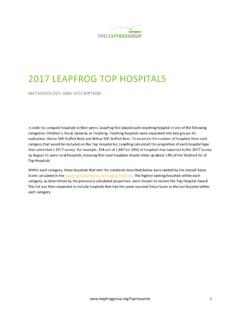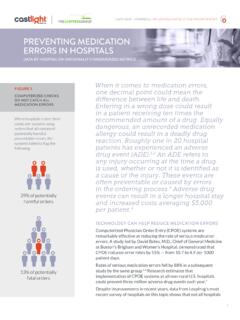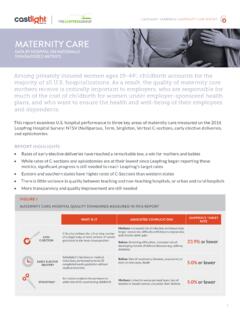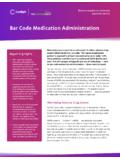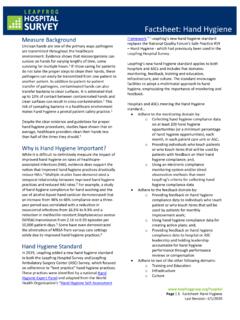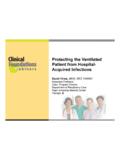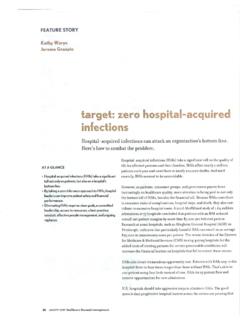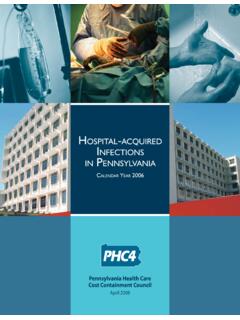Transcription of HOSPITAL-ACQUIRED CONDITIONS - Leapfrog
1 1 When a patient enters a hospital for care, the last thing he or she expects is to become sicker because of an error or accident. These often-preventable HOSPITAL-ACQUIRED CONDITIONS may result in longer stays, higher medical costs, and poorer patient outcomes, making it critical for providers to take the proper precautions to avoid such incidents. This report examines hospital performance in preventing two of the more harmful and preventable HOSPITAL-ACQUIRED CONDITIONS , HOSPITAL-ACQUIRED pressure ulcers and HOSPITAL-ACQUIRED injuries, as measured on the 2016 Leapfrog hospital HIGHLIGHTS Rates of HOSPITAL-ACQUIRED pressure ulcers and injuries have been steadily decreasing over the past four years Though the percentage of hospitals meeting Leapfrog s standards has increased.
2 There is ample room for improvement only 35% of responding hospitals met Leapfrog s standard for both measures in 2016 Hundreds of lives and millions of dollars could be saved if hospitals reduced their rates of these HOSPITAL-ACQUIRED CONDITIONS to zero Variation in performance among hospitals is significant, even within the same city More transparency and quality improvement are neededHOSPITAL- acquired CONDITIONSDATA BY hospital ON NATIONALLY STANDARDIZED METRICSCASTLIGHT - Leapfrog | HOSPITAL-ACQUIRED CONDITIONSFIGURE 1 HOSPITAL-ACQUIRED CONDITIONS STANDARDS MEASURED IN THIS REPORTWHAT ARE THEYLEAPFROG S STANDARDA pressure ulcer is a sore or wound on the skin that forms when a patient lays or sits in one position for too long without being moved.
3 This report focuses on Stage III and IV pressure ulcers, an advantaged stage bedsore that can become large and very deep. They can reach a muscle or bone and cause severe pain and serious infection. This can lead to longer hospital stays, amputation, or even per 1,000 inpatient dischargesFalls or other traumatic injuries (broken or dislocated bones, crushing injuries, or burns) that occur while a patient is in the hospital . Falls many of which can be avoided can happen when patients who can t really walk without assistance try to get out of bed, often to use the bathroom. These preventable accidents increase the length of hospital stays, require additional care, and may result in permanent disability or even per 1,000 inpatient discharges HOSPITAL-ACQUIRED PRESSURE ULCERSHOSPITAL- acquired INJURIES*These measures do not apply to pediatric facilities or critical-access hospitals that don t collect present-on-admission (POA) indicators (which are scored as Does Not Apply).
4 Other facilities that indicate they don t collect POAs or that don t submit a survey are scored as Declined to Respond. 2 CASTLIGHT - Leapfrog | HOSPITAL-ACQUIRED CONDITIONSSTEADY DECLINES IN HOSPITAL-ACQUIRED CONDITIONSE fforts to combat HOSPITAL-ACQUIRED CONDITIONS like pressure ulcers and injuries accelerated with the 2011 launch of the Department of Health and Human Services (HHS) Partnership for Patients (PfP) program. Administered through the Centers for Medicare & Medicaid Services (CMS), PfP was designed to encourage acute-care hospitals to reduce the rate of HOSPITAL-ACQUIRED CONDITIONS . The Partnership for Patients program and related efforts had an immediate and dramatic effect, eliminating an estimated 50,000 deaths due to HOSPITAL-ACQUIRED CONDITIONS and reducing the cost of care by approximately $12 billion between 2010 and to this year s Leapfrog hospital Survey, those gains have continued.
5 The percentage of reporting hospitals fully meeting Leapfrog s standard for HOSPITAL-ACQUIRED pressure ulcers has risen from 53% in 2013 to 69% in 2016. For HOSPITAL-ACQUIRED injuries, the percentage of hospitals fully meeting the Leapfrog standard grew from 25% in 2013 to 44% in 2016. This progress can likely be attributed to the increased attention focused on adverse events. This includes: Greater financial incentives offered by CMS and other payers policies Increased public reporting of hospital -level results (such as through the Leapfrog hospital Survey) Performance improvement technical assistance provided as part of the PfP program, hospitals Quality Improvement Organizations (QIOs), and efforts by the Agency for Healthcare Research and Quality (AHRQ)Still, in 2016, only 35% of all applicable hospitals met Leapfrog s targets on both measures, compared to less than 26% of applicable hospitals that met both standards in AND DOLLARS AT STAKEThe average rate of HOSPITAL-ACQUIRED pressure ulcers across reporting hospitals was.
6 102 pressure ulcers per 1,000 inpatient discharges in 2016 compared to .122 in 2013, a 16% improvement. The average rate of HOSPITAL-ACQUIRED injuries was .419 injuries per 1,000 inpatient discharges among reporting hospitals in 2016 compared to .521 in 2013, an improvement of nearly 20%.These gains have resulted in an estimated savings of 49 lives and more than $33 million dollars. However, if all hospitals had reduced their rates of pressure ulcers and HOSPITAL-ACQUIRED injuries to zero over that same time period, an estimated 263 lives and $175 million dollars could have been saved. These calculations were performed using Leapfrog s Lives and Dollars Lost Calculator, which FIGURE 2 MORE HOSPITALS MEETING Leapfrog S STANDARD FOR HOSPITAL-ACQUIRED PRESSURE ULCERS AND INJURIESPRESSURE ULCERS: PERCENT FULLY MEETING Leapfrog S STANDARDINJURIES: PERCENT FULLY MEETING Leapfrog S STANDARD65%70%60%55%50%45%20132014201520 1640%45%35%30%25%20%2013201420152016 3 CASTLIGHT - Leapfrog | HOSPITAL-ACQUIRED CONDITIONS incorporates national estimates of inpatient-attributable mortality rates and average costs associated with treating each HOSPITAL-ACQUIRED condition.
7 There is no time to waste on the improvement that hospitals must strive for to reduce these costs in lives and THE RIGHT hospital : PERFORMANCE CAN VARY SIGNIFICANTLY EVEN WITHIN THE SAME CITYAs a patient, your risk of being injured or suffering from pressure ulcers while being hospitalized can vary significantly among hospitals, even within the same metro area. According to data from the 2016 Leapfrog hospital Survey, the rate of HOSPITAL-ACQUIRED injuries in Chicago ranged from zero at one hospital to as much as per 1,000 inpatient discharges at another just three miles away. Similar spreads were seen at hospitals within a mile or two of one another within New York and Los , the rate of HOSPITAL-ACQUIRED pressure ulcers in the New York metro ranged from zero at one hospital to per 1,000 inpatient discharges at another institution less than four miles away.
8 LA and Chicago area hospitals showed not as dramatic but still worrisome gaps in performance on this important measure. Patients can enhance their odds of avoiding HOSPITAL-ACQUIRED CONDITIONS by using Leapfrog s publicly reported results to guide their choice of TRANSPARENCY AND QUALITY IMPROVEMENT NEEDEDW hile appreciating the steady progress that hospitals are making on HOSPITAL-ACQUIRED CONDITIONS , there is still considerable room for improvement, as most of these incidences are preventable by simply taking appropriate precautions, such as following recommended protocols regarding skin care and turning/repositioning patients or implementing bathroom schedules and fall-proofing hospital rooms. Improving on these measures would not only result in better patient outcomes, but could also reduce medical costs by thousands of dollars for patients and payers.
9 What s more disappointing, many hospitals declined to report their data all. Transparency not only earns trust from patients, families, and payers, but also galvanizes quality-improvement efforts within hospitals. Institutions that report to the Leapfrog hospital Survey assess their performance compared with other hospitals nationally and hold themselves to the highest standards of improvement. FIGURE 3 RATES FOR HOSPITAL-ACQUIRED CONDITIONS (PER 1,000 PATIENT DISCHARGES) VARY GREATLY WITHIN CITIESP ressure ulcer rateInjury rateInjury rateHOSPITAL AHOSPITAL BHOSPITAL AHOSPITAL BHOSPITAL AHOSPITAL BNew : 1 mileDistance: 2 milesDistance: 3 : This analysis represents the highest and lowest rates of HOSPITAL-ACQUIRED CONDITIONS within all hospitals collecting present-on-admission (POA) data within the NY, LA , and Chicago metro areas, separated by distances ranging from one to five Health, Spear Street, Suite 40 0 San Francisco, CA 94105Te l: 41 5.
10 8 2 0 2017 Castlight Health, Inc. Castlight Health is the registered trademark of Castlight Health, Inc. 4 CASTLIGHT - Leapfrog | HOSPITAL-ACQUIRED CONDITIONSMETHODSThe Leapfrog Group annually invites all adult general acute care and free-standing pediatric hospitals in the United States to voluntarily report to the Leapfrog hospital Survey, which collects and publicly reports data by hospital on topics including high-risk procedures, maternity care, HOSPITAL-ACQUIRED CONDITIONS , medication safety, nursing safety, and never events through its annual hospital survey. In 2016, 1,859 hospitals submitted a survey, representing nearly half of hospitals nationwide and 62% of hospital beds. Participation is free to hospitals and results are free to the public.

